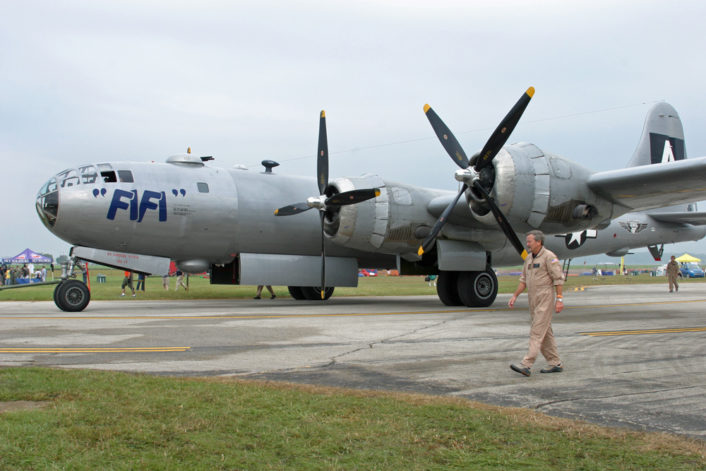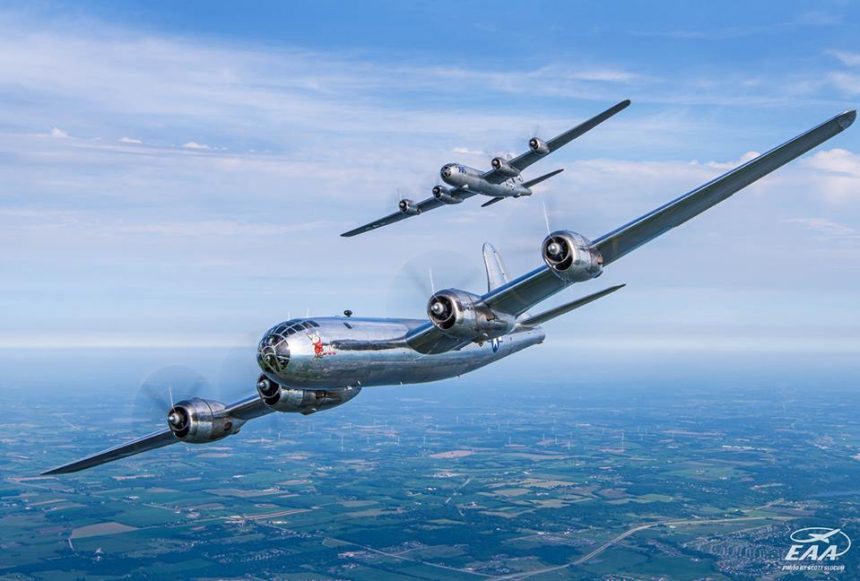First B-29 Formation in Over 50 Years Gets Airborne at Oshkosh, Wisconsin.
For the first time since the early 1960’s when they were retired from U.S. Air Force service, two Boeing B-29 Superfortress heavy bombers flew together in formation at the AirVenture Airshow in Oshkosh, Wisconsin.
The two aircraft, “Fifi”, aircraft number N529B and “Doc”, aircraft N69972, took to the air in formation at Oshkosh on Tuesday of this week. They were accompanied by a camera aircraft and a B-25 Mitchell twin-engine medium bomber.
One of thousands of aviation enthusiasts and pilots at Oshkosh who witnessed the first formation flight, Ethan Jones, told TheAviationist.com, “It was jaw dropping. Being able to witness this flight was a moment many have been waiting for.” Jones traveled across the U.S. along with his wife for AirVenture. “We wanted to be surrounded with like-minded people for a week and see why they call EAA AirVenture Oshkosh ‘The Greatest Aviation Celebration’”.
Both of the B-29’s in Tuesday’s historic “reunion” flight have fascinating histories.
The B-29 aircraft number N529B named “Fifi” has been an attraction at airshows in the U.S. for a number of years. “Fifi” was purchased from surplus in 1971 and flew again for the first time in August of that year. It took another three years to restore her to certified flight status. In 2006 “Fifi” was grounded to begin replacement of her historically problematic Wright R-3350 Cyclone engines. Throughout the operational history of the B-29 the engines required frequent maintenance and were prone to problems including fires. “Fifi” received new engines pieced together from more advanced versions of the R-3350 over three years finishing up in 2010. The re-engining project cost an estimated $3 million USD. She returned to flight following the re-engining and has been an airshow headliner ever since.
B-29 aircraft number N69972, named “Doc”, is the newer arrival to the only two flying B-29’s in the world. “Doc” is from Boeing’s Wichita, Kansas factory and was built in 1944. He was never flown in combat. The aircraft was purchased from an aviation museum by a private non-profit in 2013. The non-profit returned the aircraft to flight status on July 17, 2016 when it made its first flight in 60 years. Prior to his purchase and restoration “Doc” had sat in outdoor desert storage on the way to being used as a target for years.
The B-29 Superfortress made history as the only aircraft to deliver operational nuclear strikes. Two B-29’s, the “Enola Gay” and “Bock’s Car” dropped single nuclear weapons on Japanese targets Hiroshima and Nagasaki on August 6 and August 9, 1945 toward the conclusion of WWII. Both of those nuclear strike aircraft are preserved in museums. The nuclear attacks were intended to force Japan to surrender and avoid a U.S. invasion of Japanese islands that was projected to result in over a half million casualties according to U.S. estimates at the time.
The B-29 Superfortress featured major technical innovations including pressurized crew compartments and a remotely controlled defensive gun system. A pressurized tunnel ran from the forward section of the aircraft to the aft section over the bomb bay. Unlike the Boeing B-17 Flying Fortress, its predecessor, the B-29 Superfortress uses a modern, heavy-duty tricycle landing gear system.
The eight-day Air Venture airshow at Oshkosh concludes this weekend. “Fifi” and “Doc” are scheduled to fly one more demonstration sortie together at the show before they resume their individual airshow appearances for the rest of the season.

Top image: Top aviation photographer Scott Slocum captured this remarkable portrait of “Fifi” and “Doc”, the only flying B-29’s in the world, in formation for the first time for EAA – The Spirit of Aviation. (Credit: EAA/Scott Slocum)









